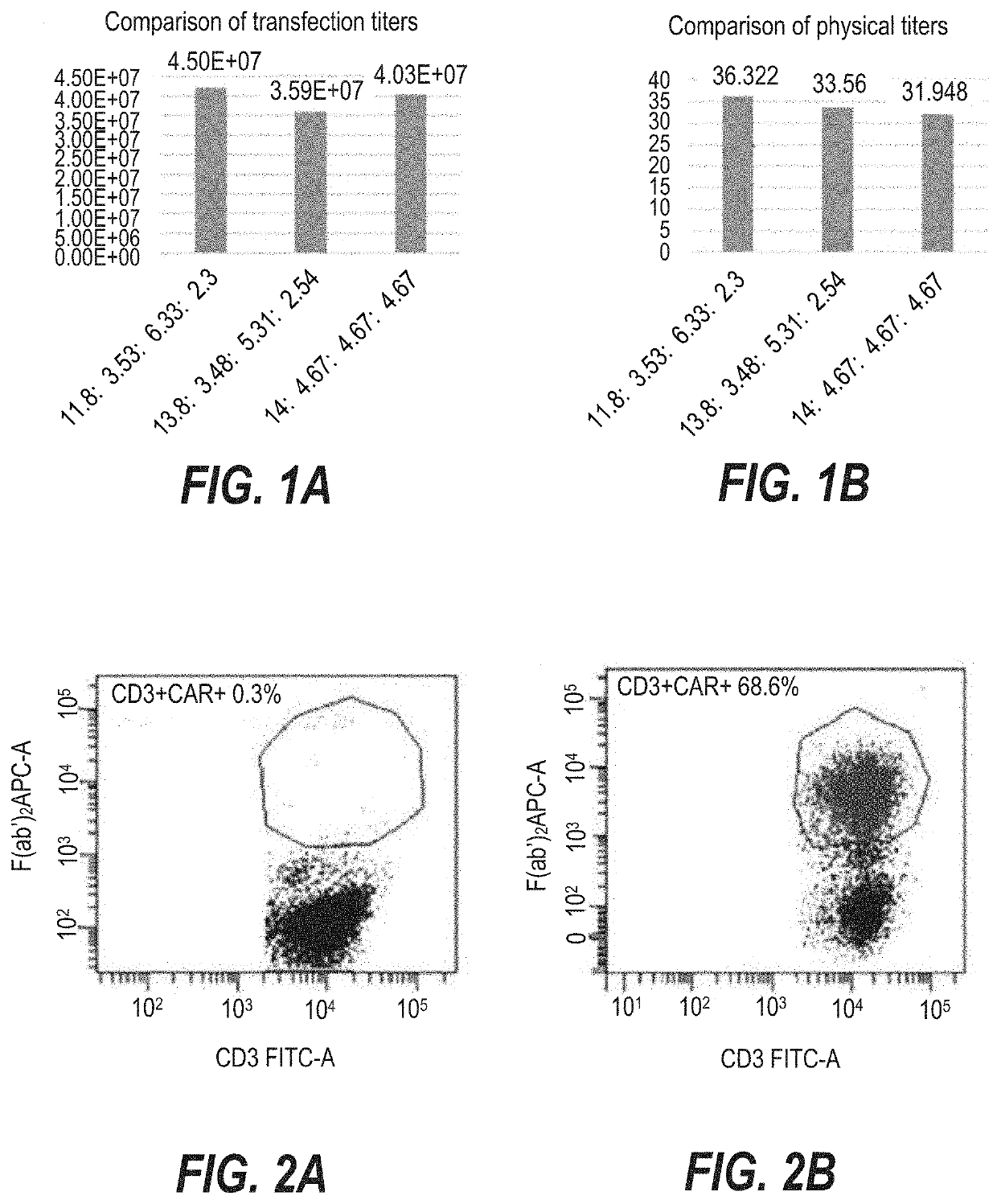Plasmid combination and application thereof in preparing modified immune cells
a technology of immune cells and plasmids, applied in the field of biomedicine, can solve the problems of relapse or refractory leukemia, difficult to tackle, high cost, etc., and achieve the effects of enhancing the ability of t cells, strong ability to kill, and promoting immune cells to secrete cytokines
- Summary
- Abstract
- Description
- Claims
- Application Information
AI Technical Summary
Benefits of technology
Problems solved by technology
Method used
Image
Examples
example 1
Construction and Preparation of a Lentiviral Vector
[0150]A fragment containing the CAR structure described in the present disclosure (its amino acid sequence and nucleotide sequence are shown in SEQ ID NO. 1 and SEQ ID NO. 2, respectively) was artificially synthesized, and constructed into a modified empty vector (manufacturer: SBI Corporation, catalog number: CD500-CD800). Three helper plasmids were used for packaging to obtain a lentiviral vector, and the obtained lentiviral vector was named the expression vector CNCT19. The specific steps are described as follows.
[0151]1.1 Construction of a Plasmid Vector
[0152]In the present disclosure, a four-plasmid system containing a target plasmid (Seq1), PMD2.G, pMDLg-pRRE and pRSV-Rev was used.
[0153]Firstly, the target plasmid Seq1 was constructed. An empty vector (manufacturer: SBI System BioScience; name: PCDH-EF1-MCS-T2A-copGFP; catalog number: CD526A-1) was cleaved with the two restriction enzymes Nhe I (GCTAGC) and Not I (GCGGCCGC), a...
example 2
Preparation of T Cells Infected with Lentiviruses
[0175]The infection experiment was carried out according to conventional methods known to those skilled in the art. The steps of infection are briefly described as follows:
[0176]1. Sorting of T Cells
[0177]Peripheral blood mononuclear cells (PBMC) were isolated from the subject's apheresis cells, and then T cells were sorted from the PBMC cells.
[0178]2. Activation of the T Cells
[0179]The isolated T cells were resuspended with complete lymphocyte culture medium (Xvivo15 medium+5% FBS+100 IU / ml IL-2 or Xvivo15 medium+5% FBS+20 ng / ml IL-21+10 ng / ml IL-7) to give a final concentration of (1˜2)×106 cells / ml, and 5 to 10 μl of CD3 / CD28 stimulation magnetic beads were added. The mixture was well mixed, and placed in an incubator for culture for at least 24 h under the culture condition of 37° C.+5% CO2.
[0180]3. Infection of T Cells with Lentiviruses
[0181]The activated cultured T cells were taken out, and polybrene at a final concentration of ...
example 3
Detection of the Expression of CAR Molecules on the Surface of CNCT19 Cells
[0184]The steps of the experiment are as follows:
[0185](1) The CNCT19 cell suspension was centrifuged at 300 g for 5 min, the supernatant was discarded, sheath fluid was added to resuspend until the viable cell density reached (0.5˜1)×107 cells / ml.
[0186](2) Two flow cytometry tubes were taken for each sample, and labeled Tube 1 and Tube 2; Tube 1 was a blank control and there was no need to add antibodies to it, and to Tube 2 was added 10 μL of a ten-fold dilution of Alexa Fluor® 647-goat anti-mouse IgG F(ab′)2 antibody (manufacturer: Jackson, catalog number: 115-605-072).
[0187](3) To each tube was added 100 μl of cell suspension, and reaction was performed for 15 to 20 min in the dark at room temperature.
[0188](4) To each tube was added 2 ml of sheath fluid for washing, and centrifugation was performed at 300 g for 5 min.
[0189](5) The supernatant was discarded, and 20 μl of FITC-CD3 (manufacturer: Tongsheng ...
PUM
| Property | Measurement | Unit |
|---|---|---|
| Electrical resistance | aaaaa | aaaaa |
| Refractory | aaaaa | aaaaa |
Abstract
Description
Claims
Application Information
 Login to View More
Login to View More - R&D
- Intellectual Property
- Life Sciences
- Materials
- Tech Scout
- Unparalleled Data Quality
- Higher Quality Content
- 60% Fewer Hallucinations
Browse by: Latest US Patents, China's latest patents, Technical Efficacy Thesaurus, Application Domain, Technology Topic, Popular Technical Reports.
© 2025 PatSnap. All rights reserved.Legal|Privacy policy|Modern Slavery Act Transparency Statement|Sitemap|About US| Contact US: help@patsnap.com



